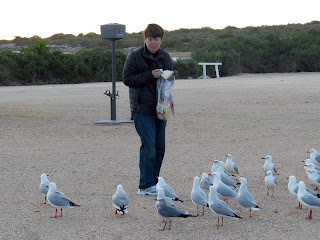Venus Bay is 662 kilometres from Adelaide. Roger said I was mad, but of course I was up for it. A possible tick was all I could think of as we hurried back to Melbourne with our cargo of sherry. The next day, Sunday, James and I had an uneventful flight to Adelaide and picked up our hire car from Avis. Luckily, they did not add any silly conditions such as that we couldn't drive at night. We left the airport at 11.20 a.m., and drove directly to Venus Bay with just a couple of petrol stops. Food was a secondary consideration. Traffic was good, there was a little rain and some pesky roadworks to negotiate, but all went well. It was dark by about 5.30 p.m. and we arrived at Venus Bay by about 7. Street lights are not a major part of the infrastructure of Venus Bay. Nevertheless we found the caravan park quite easily.
The charming woman in the office told us that the bird had been around since May, but had only been identified the previous week (21 July). Birders were now flocking to the caravan park, and we were made to feel most welcome. I knew the birder in the cabin next door, so we knocked on his door to get the latest news about the gull. He assured us that he'd seen it that morning, but it had been absent all afternoon as the weather had been wet and gusty. Until then, I'd had no doubt that we would see this 'easily tickable' bird. Now the doubts started to set in.
It was a cold night. I tossed and turned, worrying that the bird would not appear. At what time should I persuade James that we must return home? How much time could we give this bird to put in his appearance?
We were up early, waiting for it to be sufficiently light to identify gulls. At 7.30, we joined a couple of other eager twitchers, and sauntered over to the gulls hanging around the foreshore hoping for a free feed. I'm ashamed to say that we obliged. We threw them unhealthy bread and encouraged them to make as much noise as possible. We had about twenty Silver Gulls and one or two Pacifics gathered around us enjoying our carbohydrates. I was nagged by doubt. We should really leave by 9, I thought. But how would I possibly persuade James to leave if the bird had not appeared?
We ran out of bread, and James said he'd return to our cabin to replenish supplies. I told him to bring the Laughing Gull back with him. Obedient fellow that he is, he did! He yelled to us that the gull was flying in, and we turned to admire it fly over his head and come down to join our flock of Silver Gulls. I was delighted and relieved.
 |
| Laughing Gull at Venus Bay, photo by James Mustafa |
We spoke to it. We admired it. We thanked it for appearing. Shame on us, we even fed it. It did not fly up to catch thrown bread as did the Silver Gulls. It stood stupidly waiting for the bread to come to it. It opened its black bill to reveal a very pink mouth and mewed. It did not laugh. Someone said that Laughing Gulls only laugh at their breeding sites.
 |
| Me (very naughtily) feeding gulls, including the Laughing Gull Photo by James Mustafa |
 |
| Laughing Gull photo by James Mustafa |
 |
| Paul Newman, me and James admiring the Laughing Gull Photo by Paul Taylor |
I had no problem dragging James away. We admired the bird. He took his photo. We congratulated each other on our extreme brilliance and exceptional birding abilities in managing to see a rare gull precisely where we'd been told it would be, then we set off home.
We left at 8.15 a.m. A few kangaroos hopped across our path on the road out of Venus Bay. This was Monday and there were road trains to contend with on the Eyre Highway that hadn't bothered us yesterday. It rained sporadically and some selfish caravans thought that 40 kph was an appropriate speed to travel on the highway. We paused for lunch at noon at the Arid Lands Botanic Gardens in Port Augusta (site 47 in my Best 100 Birdwatching Sites in Australia). It was cold and windy, but we had a quick walk to the bird hide nevertheless. James photographed a Chirruping Wedgebill, and his sharp eyes picked out a pair of Spotted Harriers, a male White-winged Fairywren, and a Rufous Songlark as well as the usual honeyeaters and babblers.
 |
| Chirruping Wedgebill at Arid Lands Botanic Gardens Photo by James Mustafa |
Then, it was on to the airport to wait for our flight home. It was all quite easy really. That dear little Laughing Gull gave us more pleasure than it will ever know. Roger still thinks I'm mad, but he has to concede that I got my tick!









